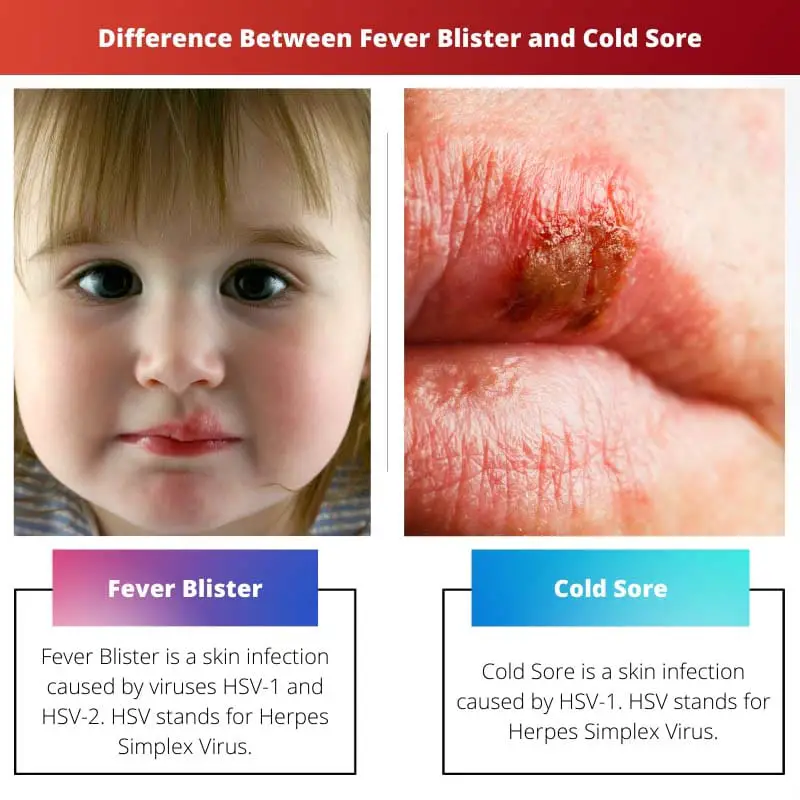Infectious diseases caused by viruses are not uncommon. Some of the most common infectious diseases include the common cold, chickenpox, flu, etc.
While most such diseases are not as severe, they have common symptoms. Two such infections are fever blister and cold sore. While the two are mostly similar, they have a slight differentiating factor.
Key Takeaways
- Fever blisters and cold sores are caused by the herpes simplex virus (HSV) and manifest as small, fluid-filled blisters around the mouth.
- The terms “fever blister” and “cold sore” are used interchangeably, as they both refer to the same condition.
- Treatment for fever blisters and cold sores includes antiviral medications, over-the-counter creams, and home remedies to manage symptoms and reduce healing time.
Fever Blister vs Cold Sore
Fever blisters are highly contagious and spread through fluid or skin-to-skin contact. Fever blisters or cold sores are painful and can be accompanied by other symptoms such as fever and sore throat. The virus can be dormant for long periods and triggered by stress or exposure to sunlight.

A fever Blister is a skin infection caused by viruses HSV-1 and HSV-2. HSV stands for Herpes Simplex Virus, the two forms of which are the primary cause of fever blister.
The infection results in tiny and painful blisters around the lips and mouth. The disease mostly occurs in groups, which makes the condition likely to spread to other areas of the skin.
Cold Sore is a skin infection caused by HSV-1. HSV stands for Herpes Simplex Virus, one form of which is the primary cause of the cold sore. The condition results in red and swollen wounds around the lips and mouth.
The infection mainly occurs in groups by HSV-1 but can also be accompanied by HSV-2. In such a case, the disease develops into a fever blister.
Comparison Table
| Parameters of Comparison | Fever Blister | Cold Sore |
|---|---|---|
| Virus | HSV-1 causes it. | It is caused by HSV-1. |
| Causes | Stress, cold, allergies, etc. | Food choices, Allergies, etc. |
| Symptoms | Tiny, painful blisters. | Red and swollen wounds around the mouth. |
| Type | It is a chronic condition. | It is acute. |
| Remedies | L-lysine, Zinc therapy. | Applying alcohol, Ice for compression, etc. |
What is Fever Blister?
A fever Blister is a skin infection caused by viruses HSV-1 and HSV-2. HSV stands for Herpes Simplex Virus, the two forms of which are the primary cause of fever blister.
The infection results in tiny and painful blisters around the lips and mouth. The disease mostly occurs in groups, which makes the condition likely to spread to other areas of the skin.
After a few days of infection, clear fluid or pus is released from the area, including the two viruses. After the liquid is removed, scabs are formed on the affected area.
During this stage, fever blisters are the most contagious as the virus is likely to spread. After the scab is formed, it seems that the infection is healing. However, the already-spread viruses can continue to be contagious, which results in further complications.
In the early stages, a fever blister seems like a cold sore, as the symptoms are mostly the same. Fever blister can only be identified in its later stages as the virus causing the two conditions is the same.
Therefore, it is necessary to get the condition medically checked. The treatment includes drug-based medicines such as acyclovir, valacyclovir, famciclovir, etc.
What is Cold Sore?
Cold Sore is a skin infection caused by HSV-1. HSV stands for Herpes Simplex Virus, one form of which is the primary cause of the cold sore. The condition results in red and swollen wounds around the lips and mouth.
The infection mainly occurs in groups by HSV-1 but can also be accompanied by HSV-2. In such a case, the disease develops into a fever blister.
After a few days of infection, the area starts to heal, and sometimes it releases a clear fluid or pus, including the virus. HSV-1 itself is not as contagious as when HSV-2 accompanies it.
In the early stages, it is unknown if both viruses are present or not. When the infection starts to spread or the symptoms worsen, it is a sign of both viruses being present.
A few home remedies can relieve symptoms and pain, such as ice compression, applying small amounts of alcohol, and cream painkillers, etc.
If home remedies don’t work or the infection spreads to other areas of the skin, the infection must be diagnosed immediately. In such a case, a fever blister can be the infection.

Main Differences Between Fever Blister and Cold Sore
- Both HSV-1 and HSV-2 cause a fever blister, whereas HSV-1 causes a cold sore.
- Fever blister is a chronic condition, whereas cold sore is an acute condition.
- The symptoms of a fever blister are more painful and visible, whereas the symptoms of a cold sore are intermediate and less visible.
- Fever blister can lead to other complications as infection can spread to other areas of the skin. On the other hand, a cold sore itself is not anything complicated.
- Fever blisters must be professionally treated, whereas home remedies can heal cold sores.





